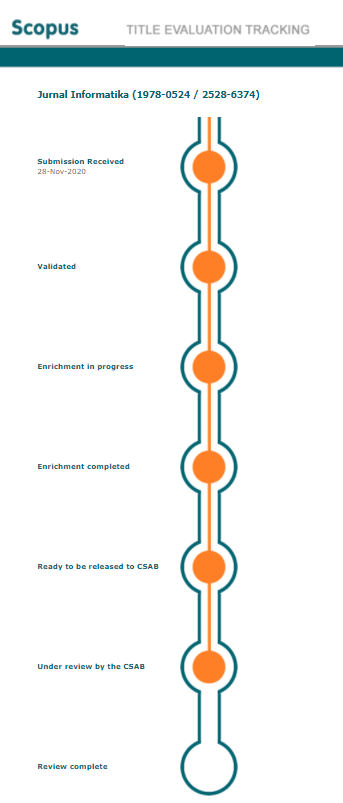Forecasting chicken meat and egg in indonesia using ARIMA and SARIMA
Abstract
Full Text:
PDFReferences
“Indonesia: beef consumption per capita 2031 | Statista.” https://www.statista.com/statistics/757351/indonesia-beef-consumption-per-capita/ (accessed Dec. 08, 2020).
T. M. Dewi and H. Cahyono, “Pengaruh Pertumbuhan Ekonomi, Bi Rate, Dan Inlfasi Terhadap Investasi Asing Langsung Di Indonesia,” J. Pendidik. Ekon., vol. 4, no. 3, pp. 1–7, 2016.
A. T. Septifany, R. R. Hidayat, and S. Sulasmiyati, “PENANAMAN MODAL ASING DI INDONESIA ( Studi Pada Bank Indonesia Periode Tahun 2006-2014 ),” J. Adm. Bisnis, vol. 25, no. 2, pp. 1–7, 2015.
S. Sugiartiningsih, “Pengaruh Inflasi Indonesia Terhadap Penerimaan Penanaman Modal Asing Langsung Korea Selatan Di Indonesia Periode 2000-2014,” J. Manaj. Maranatha, vol. 17, no. 1, p. 33, 2017, doi: 10.28932/jmm.v17i1.416.
S. Sukirno, Pengantar Teori Makroekonomi Edisi Kedua, Ke 14. Jakarta: PT.Raja Grafindo Persada, 2002.
N. Ilham and nFN Saptana, “Fluktuasi Harga Telur Ayam Ras dan Faktor Penyebabnya,” Anal. Kebijak. Pertan., vol. 17, no. 1, pp. 27–38, Jun. 2019, doi: 10.21082/AKP.V17N1.2019.27-38.
F. Sugiharta, “Aplikasi Metode Peramalan Terhadap Harga Komoditas Cabai Merah Sebagai Dasar Pengambilan Keputusan Para Pelaku Perdagangan,” 2002, Accessed: Dec. 08, 2020. [Online]. Available: http://repository.ipb.ac.id/handle/123456789/17047.
D. Peter and P. Silvia, “ARIMA vs. ARIMAX – which approach is better to analyze and forecast macroeconomic time series?,” Int. Conf. Math. Methods Econ., no. 2, pp. 136–140, 2012.
F. N. Hadiansyah, “Prediksi Harga Cabai dengan Pemodelan,” vol. 2, no. 2010, pp. 71–78, 2017, doi: 10.21108/indojc.2017.21.144.
D. P. Anggriningrum, P. Hendikawati, and Z. Abidin, “PERBANDINGAN PREDIKSI HARGA SAHAM DENGAN MENGGUNAKAN JARINGAN SYARAF TIRUAN BACKPROPAGATION DAN ARIMA,” Unnes J. Math., vol. 2, no. 2, Nov. 2013, doi: 10.15294/UJM.V2I2.3249.
W. Hu, S. Tong, K. Mengersen, and D. Connell, “Weather Variability and the Incidence of Cryptosporidiosis: Comparison of Time Series Poisson Regression and SARIMA Models,” Ann. Epidemiol., vol. 17, no. 9, pp. 679–688, Sep. 2007, doi: 10.1016/J.ANNEPIDEM.2007.03.020.
M. Sami et al., “Prediction of the rate of dust fall in Quetta city, Pakistan using seasonal ARIMA (SARIMA) modeling,” undefined, vol. 7, no. 10, Mar. 2012, doi: 10.5897/IJPS11.1357.
F. F. Nobre, A. B. S. Monteiro, P. R. Telles, and G. David Williamson, “Dynamic linear model and SARIMA: a comparison of their forecasting performance in epidemiology,” Stat. Med., vol. 20, no. 20, pp. 3051–3069, Oct. 2001, doi: 10.1002/SIM.963.
E. B. Dagum, “The X-II-ARIMA seasonal adjustment method,” no. January 1980, p. 119, 1980, [Online]. Available: https://publications.gc.ca/site/eng/9.845219/publication.html.
S. C. Hillmer and W. W. S. Wei, “Time Series Analysis: Univariate and Multivariate Methods.,” Journal of the American Statistical Association, vol. 86, no. 413. p. 245, 1991, doi: 10.2307/2289741.
F. Pakaja, A. Naba, and P. Purwanto, “Peramalan Penjualan Mobil Menggunakan Jaringan Syaraf Tiruan dan Certainty Factor,” J. EECCIS (Electrics, Electron. Commun. Control. Informatics, Syst., vol. 6, no. 1, pp. 23–28, 2012, doi: 10.21776/JEECCIS.V6I1.162.
DOI: http://dx.doi.org/10.26555/jifo.v16i1.a25416
Refbacks
- There are currently no refbacks.
Copyright (c) 2022 M D Wisodewo, H A Rosyid, A R Taufani

This work is licensed under a Creative Commons Attribution-ShareAlike 4.0 International License.
____________________________________
JURNAL INFORMATIKA
ISSN :Â 1978-0524 (print) | 2528-6374 (online)

This work is licensed under a Creative Commons Attribution-ShareAlike 4.0 International License.






